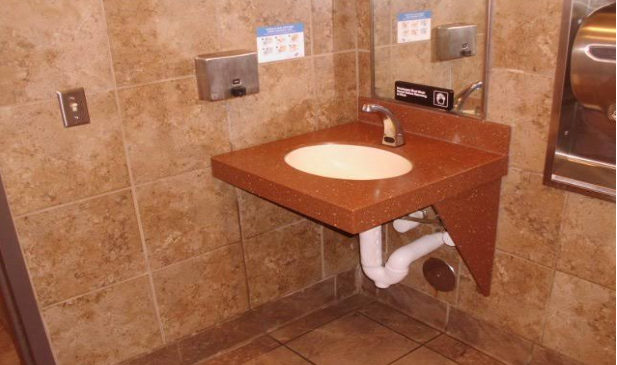

When it comes to educational standards in schools, the focus is mainly on the standard of education and not the environment. The environment is also critical for learning, hence an accessible environment makes it easier for students to learn better.
Schools must follow all ADA rules and guidelines to ensure accessibility throughout their campuses. This article will explore some of the requirements for ADA compliance in schools. Continue reading to learn more:
One of the ADA requirements for schools is that the routes to the campus must be accessible. This includes the parking lots and building entrances too. These routes must be wide enough to allow students using mobility aids such as wheelchairs to navigate their way around the school without any inconvenience. The minimum width for the entrance into a classroom should be 36 inches. Also, the doors should be easy to open and if possible should be automatic doors that open when it detects nearby movement. Entrances to the playground and recreational centres around the school environment should also be accessible to everyone.
The classrooms should be designed to accommodate students with disabilities. This means that the desks, tables and other furniture should be arranged such that there will be free movement and that students in wheelchairs can navigate the space conveniently.
Also, the classroom furniture should be designed such that it can be adjusted to meet the needs of students with special physical requirements. The school must also provide equipment and technology in the classrooms to assist students with hearing or visual impairments.
An ADA-compliant restroom is a compulsory requirement in a school. The restrooms must be accessible with at least one stall designed to accommodate wheelchair users. There should be grab bars in the stalls to provide support and stability for people with disabilities. The stalls should also be wide enough to allow wheelchair users to manoeuvre their way around.
These days, people are relying heavily on digital platforms and technology to get tasks done. These technologies can also be applied to schools to improve learning for students and teaching for teachers.
Implementing technology and learning resources in schools involves ensuring that websites, online portals and other software are accessible to every student in the school. And when these resources are not readily available, there should be alternatives when necessary. Teachers should undergo the necessary training to learn how to use these technologies to teach and impact the students.

ADA compliance in schools is necessary for improving the learning process of students and facilitating the teaching process of teachers. Following all ADA requirements is necessary to avoid legal penalties and fines and ensure that the school is up to standard for an ADA inspection certification. It also ensures an accommodating environment for students with disabilities and gives them equal access to learning and school facilities like everyone else.

When considering the safety and accessibility of all users in a restroom, sink clearance plays a crucial role. The amount of space around a sink

Building an ADA-compliant kitchen doesn’t have to involve a full renovation. With a few adjustments, you can ensure ADA clearance in your kitchen and make

When it comes to educational standards in schools, the focus is mainly on the standard of education and not the environment. The environment is also critical for learning, hence an accessible environment makes it easier for students to learn better.
Schools must follow all ADA rules and guidelines to ensure accessibility throughout their campuses. This article will explore some of the requirements for ADA compliance in schools. Continue reading to learn more:
One of the ADA requirements for schools is that the routes to the campus must be accessible. This includes the parking lots and building entrances too. These routes must be wide enough to allow students using mobility aids such as wheelchairs to navigate their way around the school without any inconvenience. The minimum width for the entrance into a classroom should be 36 inches. Also, the doors should be easy to open and if possible should be automatic doors that open when it detects nearby movement. Entrances to the playground and recreational centres around the school environment should also be accessible to everyone.
The classrooms should be designed to accommodate students with disabilities. This means that the desks, tables and other furniture should be arranged such that there will be free movement and that students in wheelchairs can navigate the space conveniently.
Also, the classroom furniture should be designed such that it can be adjusted to meet the needs of students with special physical requirements. The school must also provide equipment and technology in the classrooms to assist students with hearing or visual impairments.
An ADA-compliant restroom is a compulsory requirement in a school. The restrooms must be accessible with at least one stall designed to accommodate wheelchair users. There should be grab bars in the stalls to provide support and stability for people with disabilities. The stalls should also be wide enough to allow wheelchair users to manoeuvre their way around.
These days, people are relying heavily on digital platforms and technology to get tasks done. These technologies can also be applied to schools to improve learning for students and teaching for teachers.
Implementing technology and learning resources in schools involves ensuring that websites, online portals and other software are accessible to every student in the school. And when these resources are not readily available, there should be alternatives when necessary. Teachers should undergo the necessary training to learn how to use these technologies to teach and impact the students.

ADA compliance in schools is necessary for improving the learning process of students and facilitating the teaching process of teachers. Following all ADA requirements is necessary to avoid legal penalties and fines and ensure that the school is up to standard for an ADA inspection certification. It also ensures an accommodating environment for students with disabilities and gives them equal access to learning and school facilities like everyone else.